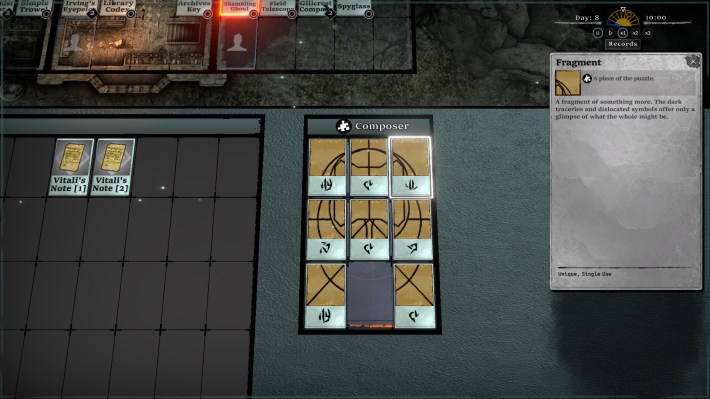For years I owned this huge illustrated Lovecraft book that I knew I should get rid of but which I struggled to finally take out to the curb: not from any attachment to the works themselves, but because the weight of the book made it perfect for pressing tofu. But I’m often curious about how works inspired by Lovecraft deal with questions of mythos and knowledge, which made recent indie card-based game The Horror At Highrook intriguing.
Highrook is, thankfully, only Lovecraftian in the sense of having cosmic beings and groups devoted to them, but in my time with its first three chapters has had more of a Victorian horror vibe in the form of people going into a grand house they should totally not be going into. You play as four investigators hired to unravel the mysterious disappearance of the wealthy Ackeron family, and you quickly learn that what seemed like a domestic issue involves the occult. Each of your characters has skills specific to their role, and those skills align with certain rooms of the Highrook manor. Astor is a mechanic who can tinker with items in the machine room; scholar Vitali is suited for research tasks in study and archives; Atticus Hawk is fit for physical tasks in the courtyard and cliffs; and Doctor Caligar can craft potions in the laboratory. Characters also have skills that align with other rooms: I found Astor best suited to cooking meals in the kitchen, while Hawk was useful for exploring the manor’s cellar.
Each room of the manor has a slot for a task card–a mysterious box to open, a code to break, a book to read–and a slot for one person to do that task. You need a certain amount of points in the room’s skill to be successful; if your character doesn’t have the base attributes, you can bolster them with additional cards representing items you can find or craft. While the early game felt like it started a little slow, with a bit of waiting for the right items to boost my stats or move the plot to appear, in my later play I’ve found myself with plenty to do, multitasking around the investigation while juggling my characters’ light survival needs for food and sleep. Highrook has often taken on the feeling of a cooperative board game, even though it’s just me playing: Hawk searching for useful items, Caligar crafting potions to boost Astor’s stats so she can unlock a code to open a new room, Vitali researching mysterious tomes found in the last box Atticus dug up.
The game so far has been somewhat linear, with certain plot items appearing rather than me moving the story forward on my own. Many of those plot threads have involved finding enough pieces of an occult symbol to unlock the next story bit about what precisely Lord Ackeron was dealing with. The writing has been a little heavy-handed at times, but it’s teased a compelling picture of how Lord Ackeron’s occult obsession affected his family, who are more than just foils to his pursuits. Your investigators also have their own conflicts and motivations, and I’ve enjoyed the tension of deciding whether I should use my stat-boosting items on the main quest or on their side quests, eager to learn more about them.

In addition to the big bads you’re pursuing, there are also smaller creepy beings around the mansion. In the early game there’s been a ghost that hops from room to room, raising the madness level of anyone it comes in contact with. I’ve had to fight beings unleashed from performing an arcane ritual in the chapel, matching the points in the room they appear to banish them back to the void. In my first encounter with these beings I found fighting them in the machine room my best bet, and I’d hurry to move my character cards from other rooms they appeared in to avoid their negative effects. Besting them unlocked items I could use to level up my investigors, making them more than just a nuisance. There’s also been a cat who wanders the grounds, sometimes taking up a character card slot and forcing me to wait to do a room’s task until he decides to move, just like a real cat.
As you can imagine, your board in Highrook quickly becomes cluttered with cards, though the game provides storage space where you can organize your items. Information isn’t always quite as clear as I’d like–I sometimes had to click through piles of cards to remember which one I needed, or cycle through my investigators to remember all their skills–but overall the game does its best to tame its chaos, and I always knew how to find the information I needed. The game also keeps your characters’ meters for hunger, fatigue, health and sanity clearly displayed, so when I was suddenly informed that a character was exhausted and had to be sent to the guest room and its sleep-inducing item to recover, I knew it was my own time management that had caused the situation rather than the game not warning me what I was headed for.
I’ve quickly been sucked into Highrook’s story and world, and I’ve found its linearity to be a good offset to the potential overwhelm of tasks and cards. I have tons of rooms of the manor left to unlock, and I’m excited to play more. If you’re looking for a cards-and-rooms game that isn’t The Horror At Blue Prince, Highrook is out now, and has a demo on Steam if you want to get a feel for it.


